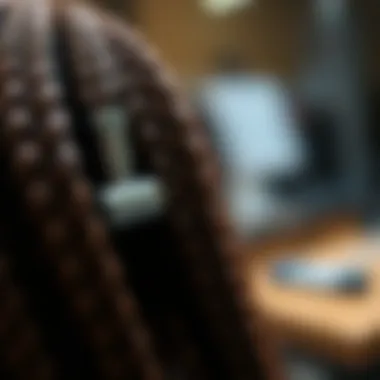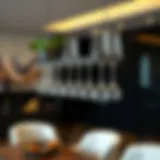Exploring the Electric Hair Braider: A Comprehensive Guide


Intro
As fashion and technology steadily collide, new tools emerge that revolutionize traditional techniques in hairstyling. Among these innovations, the electric hair braider stands out as a game changer, marrying efficiency with artistry. This guide offers an in-depth look into the electric hair braider, exploring its functionality, advantages, and relevance in modern hairstyling practices. Through a careful examination of various models, we will understand how this tool is reshaping the way we think about braiding, allowing both amateurs and professionals alike to achieve intricate styles with ease and finesse.
Gone are the days of laboriously weaving together strands of hair by hand, which often consumed significant time and required a fair amount of skill. With the rise of electric braiders, hairstyling has opened up to a broader audience. This article will not just highlight the technical aspects but also provide practical advice on maintenance and usage that any user can benefit from, ensuring optimal performance and longevity of these devices.
"The electric hair braider is not just a tool; it's a gateway to creativity, allowing individuals to explore hairstyles they might have thought too complex."
In the sections that follow, we'll delve into the nuances of fashion trends influenced by braiding technologies, explore maintenance tips, as well as discuss sustainable materials pertinent in crafting these devices. By the end of this guide, you should feel equipped to embrace this modern tool and elevate your hairstyling game to new heights.
Preamble to Electric Hair Braiders
In the realm of hair styling, electric hair braiders serve as a modern marvel that simplifies and enhances traditional braiding techniques. Their significance cannot be understated, particularly in today's fast-paced world where time is often equated with efficiency and convenience. The rise of these appliances reflects not only technological advances but also a shift in consumer preferences towards tools that promote both speed and precision in hairstyling.
Electric hair braiders come equipped with various features designed to minimize the time and effort associated with manual braiding. By automating a labor-intensive task, they cater to busy individuals—whether working professionals or parents juggling numerous responsibilities—who aspire to achieve stylish, intricate braids without dedicating hours to the process. Moreover, these devices provide a level of consistency in results that can sometimes elude hand-crafted styles, ensuring each braid is uniform in size and tension.
When considering the role of electric hair braiders, it is essential to think about several key elements:
- User-Friendly Design: Many models are designed with control settings that allow users to adjust speed and tension, making them accessible for individuals of varying skill levels.
- Versatility: Electric braiders can create a range of styles—from simple three-strand styles to more complex designs—making them suitable for different occasions and preferences.
- Accessibility: This technology is suitable for various hair types and lengths, making it adaptable to a broad audience.
The above factors underscore why an exploration of electric hair braiders is pertinent not only to fashion enthusiasts but also to industry professionals seeking to keep pace with innovations in hair care tools.
Defining Electric Hair Braiders
Electric hair braiders are specialized devices designed to automate the braiding process. Unlike traditional methods that rely solely on manual dexterity, these electric units utilize motors and specific mechanisms to intertwine hair into desired patterns. With multiple designs available, some electric braiders target a particular type of braid, while others can create a variety of styles, adding to their appeal. As we delve deeper into their functionalities, it becomes clear how these appliances transform the hair-braiding experience, making it more accessible and less daunting.
Historical Context of Hair Braiding
Hair braiding has a long and varied history, deeply intertwined with cultural significance across the globe. Dating back thousands of years, braids have been employed as an art form, a cultural marker, and a practical way to manage longer strands. From the intricate braided styles of the ancient Egyptians to the more contemporary forms seen in various cultures today, the act of braiding has evolved alongside societal changes.
The advent of electric hair braiders is a natural progression in this enduring tradition. As beauty standards have shifted and technology has progressed, the introduction of machines that facilitate braiding reflects the broader trend of merging artistry with innovation. Today, while the cultural richness of braiding remains, the means to achieve these styles has become more sophisticated, allowing contemporary audiences to explore their heritage or fashion-forward looks with the aid of modern tools.
Mechanics of Electric Hair Braiders
Understanding the mechanics behind electric hair braiders is essential for anyone considering this innovative tool. Not only can it streamline your hairstyling routine, but knowing how it works can help you harness its full potential and achieve salon-like results at home. This section explores how these devices operate, the integral components involved, and the distinct benefits they offer.
How Electric Hair Braiders Work
Electric hair braiders, at their core, function through automated mechanisms that intertwine hair strands into braids without the need for manual dexterity. When you feed the hair into the device, a motorized system takes over, ensuring that the strands are twisted and looped tightly and uniformly. The simplicity of operation is often supported by user-friendly controls that allow customization of braiding speed and style. This automation significantly reduces the time spent on braiding, making it a godsend for busy individuals.
Components of Electric Hair Braiders
A deep dive into the components helps to demystify the electric hair braider. To appreciate its functionality, one must understand three primary parts: the motor, the intertwining mechanism, and the control settings.
Motor
The motor is the powerhouse of the hair braider. Its efficiency directly affects the device's performance. A high-torque motor is preferred here as it provides sufficient power to handle various hair types and densities without stalling. This is particularly beneficial for those with thick or curly hair, as the motor can maintain consistent speed and performance.
One unique aspect of these motors is that they often feature noise reduction technology. This can be quite advantageous; no one wants a hair styling tool that sounds like a jet engine. However, be mindful of the longevity of the motor—some cheaper models can wear down faster than others, making investment in a trustworthy brand important.
Intertwining Mechanism
The intertwining mechanism is the hero behind the seamless braid. This component takes the hair supplied by the user and intertwines it with precision. What sets this mechanism apart is that it can create various braid styles—from simple three-strand braids to more complex fishtail patterns—without requiring the user to have any prior braiding experience.
However, one should note that not all mechanisms are created equal; some may struggle with very fine or very thick hair, leading to uneven results. The intricate design of the mechanism ensures that the braids have a natural look, which many users appreciate.
Control Settings
Control settings are the brain of the operation. Typically, these devices include multiple speed and style settings, allowing you to personalize the braiding process to suit your needs. Some advanced models even have temperature control features, which can be vital for users who sometimes incorporate heat styling into their routines.
The ability to adjust these settings means that users can experiment with different styles while ensuring their hair is treated with care. Many find that this not only enhances their styling versatility but also protects against heat damage, making this feature a significant draw.
Understanding these mechanics provides insight into why electric hair braiders have become a popular choice among fashion enthusiasts and industry professionals alike. As a tool that simplifies the braiding process while offering customizable results, it paves the way for fresh styles with minimal effort.
Benefits of Using Electric Hair Braiders
Electric hair braiders have carved out a niche in the hairstyling world by offering various advantages that cater increasingly to the needs of today's users. Unlike traditional methods that can be time-consuming and inconsistent, these innovative tools present solutions to common hairstyling challenges. Here, we explore two prominent benefits: time efficiency and consistency in results.


Time Efficiency
When it comes to time management in hairstyling, electric hair braiders come to the rescue. Traditional braiding, with each strand requiring individual attention, can take ages, especially if you're going for intricate styles. A regular braid might take several minutes at best; however, an electric hair braider can significantly reduce this time. For the busy individual, whether a professional rushing to work or a parent preparing for a day out, these devices streamline the process.
For instance, imagine setting up for a family function. You have only a small window to get yourself and maybe your kids ready. Using an electric hair braider can save you precious minutes. You can get a perfectly styled braid in less than half the time you would usually spend doing it by hand. This time-saving aspect allows users to focus more on enjoying events rather than fretting over their appearance.
In essence, if you're keen on combining saloon-grade results with speedy execution, electric hair braiders are a game changer—speeding up your routine without sacrificing quality.
Consistency in Results
One of the most appealing elements of electric hair braiders is their ability to produce consistent results with little effort from the user. Each time you use a traditional hand-braiding method, it’s a bit of a toss-up. You might nail a look one day while the next might result in a tangled mess. With electric hair braiders, consistency is built into the design.
These machines often come equipped with smart technology that ensures even tension across the strands being woven. That means braided sections will always look uniform and polished—an aspect that can be crucial for those taking professional photographs or appearing in public. The reliability of these devices means you no longer have to worry about whether today’s braid will match yesterday’s cohesive style.
Moreover, consistency reduces the chances of common hairstyling mistakes. Users can substantially minimize their frustration, knowing that the braider will handle the technicalities. This promotes a user-friendly experience and can be particularly advantageous for those who may not have much experience in braiding but still desire well-executed results.
"With electric hair braiders, you're not just styling hair; you're achieving a dependable and fashionable finish every single time."
In summary, the incorporation of electric hair braiders into one's grooming routine is about more than just aesthetic benefits. It's about enhancing efficiency and reliability in styling. By offering time savings and a reliable output, these tools ensure that users enjoy not only flawless hairdos but also a smoother hairstyling experience overall. This not only supports individual preferences in grooming but also highlights the sophisticated, yet practical, innovations in the beauty industry.
Types of Electric Hair Braiders
When diving into the realm of electric hair braiders, it’s essential to categorize them based on their specific attributes and functionalities. Understanding these types can guide potential buyers in selecting a device that meets their specific needs and preferences. The importance of distinguishing between various models lies in their diverse features, usability, and suitability for different hair textures and styles.
Basic Models
Basic models of electric hair braiders typically serve the essential purpose of braiding hair without the intricate features found in more advanced options. These models are generally more affordable and user-friendly, making them accessible to a broader audience. One key characteristic of these basic models is their straightforward operation.
They often have a minimalistic design, focusing on ease of use. Ideal for beginners or those who prefer simplicity over complexity, these devices allow anyone to create braided hairstyles with just the push of a button. However, the lack of advanced features may leave experienced users wanting more. For instance, a basic braider may not offer customization options, limiting the variety of styles one can achieve. Still, their effectiveness can’t be understated; they effectively braid hair into neat styles without overwhelming the user.
- Key Benefits of Basic Models:
- Cost-effective
- Simple design and usability
- Ideal for beginners
Advanced Features
As technology continues to evolve, so do hair braiders. Advanced models come equipped with innovative features that cater to more discerning hairstylists or enthusiasts seeking versatility and precision. These advanced models not only enhance efficiency but also allow for a wider range of styling options.
Auto-Temperature Control
One standout feature found in many advanced electric hair braiders is auto-temperature control. This function automatically adjusts the heat according to the hair type and its condition, safeguarding it against potential heat damage. It ensures consistent styling results while optimizing user convenience.
- Key Characteristic: The ability to detect hair type and adjust heat settings is a significant factor. It's a beneficial choice for those with diverse hair textures or those simply looking to preserve the health of their locks.
Incorporating this feature into your hair styling routine can ease concerns regarding heat damage, particularly for individuals who frequently style their hair. However, it is important to note that not all devices accurately assess hair type, which may lead to undesirable outcomes.
"Using a braider with auto-temperature control is like having a personal stylist that understands your hair’s whims. Just set it, and forget it!"
Multiple Styling Options
Advanced braiders often come with multiple styling options, enabling users to experiment with various braiding techniques and styles. This exceptional feature caters to a broader audience, from the casual user seeking a trendy look to professionals aiming to create intricate styles. The flexibility offered by multiple styling options allows users to create everything from classic braids to more complex designs such as fishtails or waterfall braids.
- Unique Features: Many of these models include interchangeable attachments or settings tailored for different braid types.
This inherent versatility is a major advantage as it empowers users to express their creativity and adapt their hairstyles to suit different occasions. However, one downside is that these advanced models may carry a heftier price tag, potentially making them less accessible to some users.
Summary
In essence, knowing the types of electric hair braiders—ranging from basic models suited for novices to advanced models offering features like auto-temperature control and multiple styling options—can significantly influence a buyer's decision. Making an informed choice helps in not only enhancing styling efficiency but also in ensuring a user-friendly experience that aligns with individual needs and hair types.
User Experience with Electric Hair Braiders
Understanding the user experience with electric hair braiders is crucial for anyone considering integrating this tool into their hairstyling routine. From novices to seasoned hairstylists, the usability of electric hair braiders can significantly influence satisfaction and outcomes. This section breaks down the essentials of ease of use and some common challenges that users might face.
Ease of Use
Electric hair braiders are, generally speaking, designed with the user in mind. Many models prioritize simplicity, making it possible for individuals without prior braiding knowledge to pick up the device and create stylish braids in no time. A well-designed electric hair braider should have an intuitive interface, requiring minimal effort for operation.


Some devices come with features like one-button activation or even automatic settings for specific styles. For many users, this cuts down on the frustration often associated with traditional braiding techniques.
However, having a user-friendly experience goes beyond just the mechanics of the tool. The comfort of handling plays a big role too. If a braider is heavy or awkward to hold, it can make the experience less enjoyable. Instead, an ergonomic design helps prevent fatigue during longer styling sessions.
Common User Challenges
Learning Curve
The learning curve for electric hair braiders can vary widely between models. Some users may find it challenging to get accustomed to the functions and features, particularly if the instructions are not straightforward. Yet, this learning curve can also represent an opportunity for growth. Users who invest the time to learn the nuances of their device often find they can achieve more complex styles than they initially thought possible.
A key characteristic of the learning curve is patience; some users might feel a bit daunted at first. Yet, as they gain experience, their comfort level and skill are likely to increase. This transition can be rewarding, as those who master the device will quickly appreciate the time efficiency and consistent results it offers. Finding online tutorials or joining forums dedicated to hair styling can also serve as excellent resources to help overcome these initial hurdles.
Hair Types Consideration
Understanding hair types is fundamental when using electric hair braiders. Each individual's hair can react differently to heat and manipulation, and some devices may not be suitable for all hair textures. For example, very fine hair can slip out of the braiding mechanism, while thick, coarse hair might require a more robust model.
A notable aspect of hair types consideration is versatility. Many advanced electric hair braiders come with adjustable settings that accommodate various hair textures, allowing users to fine-tune their experience. This feature places users in a good position because they can cater the device's performance to their specific needs, making it a popular choice for a diverse audience.
To make an informed decision, users should consider their hair type and select a braider that complements it.
Ultimately, understanding both ease of use and the potential challenges provides valuable insight for users. With awareness and preparation, anyone can confidently navigate the world of electric hair braiders.
Comparing Electric Hair Braiders to Traditional Methods
Speed and Efficiency
When talking about hairstyling, speed can often be the name of the game. Traditional hair braiding requires a lot of time and precision; it's not just about putting hair strands together but also about achieving a certain aesthetic. For someone juggling a busy schedule, this can quickly become an uphill battle. Electric hair braiders, on the other hand, promise to cut down that time significantly. When comparing both methods side by side, it becomes evident that the ability of electric devices to braid hair quickly is their ace in the hole.
One simply cannot ignore the mechanics involved here. Electric hair braiders are designed to automate the repetitive motions of braiding. That means no more separating strands manually or struggling to ensure neatness. A seasoned user might whip up intricate styles in a matter of minutes, whereas a novice using traditional techniques can find themselves battling tangles and uneven sections.
- Consider this: A traditional braid may take anywhere from 15 to 30 minutes, depending on complexity. An electric hair braider can help achieve similar results in under ten.
When it comes to efficiency, many electric models come with options tailored to various hair types, reducing the chances of errors. They adapt the braiding style to individual hair characteristics, thus offering better outcomes on a consistent basis. Overall, these capabilities can be particularly appealing for professionals who might be working on multiple clients in a day.
Styling Versatility
Now, let’s talk about versatility—something that often makes or breaks a hairstyling tool. Electric hair braiders are not just about speed; they also open up a world of possibilities. Traditional braiding techniques usually fall into a handful of familiar styles, but the electric options tend to offer various designs that can cater to different preferences and occasions. Understanding this can help consumers make informed decisions about their hairstyling needs.
Many electric hair braiders come equipped with unique features like adjustable settings and interchangeable attachments. For instance:
- Waves: Some models can create wavy styles, twisting strands into an effortless beach wave look.
- Twists or Fishtails: These designs can also be executed simply by switching settings, thus allowing for a more personalized approach to hairstyling.
In contrast, achieving such diversification through traditional methods would necessitate learning new techniques, sometimes resulting in uneven or sloppy outcomes.
As a stylist, having the ability to adapt one's approach to hair braiding by merely pressing a button can be a game-changer, especially in dynamic settings like salons or wedding events.
“Versatile styling is essential. The better equipped one is, the more attractive they become to potential clients.” -- Anonymous Stylist
To sum up, the comparison between electric hair braiders and traditional methods is not merely quantitative; it is also qualitative. Speed and versatility are significant factors that speak to the evolving nature of hairstyling. Contemplating these differences not only prepares you for effective hairstyling but also aligns you with what's trendy and efficient in today's beauty landscape.
Maintenance and Care for Electric Hair Braiders
Maintaining your electric hair braider is crucial for its longevity and effectiveness. A well-cared-for braider not only performs better but also ensures a seamless styling experience. Hair products, dust, and even moisture can accumulate on the device, which might hinder its functionality over time. Understanding proper maintenance practices can extend the life of your tool and help you achieve consistent results every time.
Cleaning Instructions
Regular cleaning is an essential part of caring for your electric hair braider. Neglecting this duty can lead to buildup that affects performance. Follow these steps for proper cleaning:
- Unplug the Device: Always start by disconnecting it from the power source to ensure safety.
- Brush off Hair Residue: Use a small brush or cloth to gently remove hair strands trapped in the braider's mechanism. This can usually be done after each use.
- Wipe Down Surfaces: With a damp cloth, wipe the exterior of the braider. Be careful to avoid getting any moisture near the motor or electronic components.
- Deep Cleaning: Once a month, consider doing a deep clean. You can use a soft toothbrush to reach nooks and crannies where hair product might build up. Some users find a solution of water and mild soap effective for tougher spots. Just remember to dry the device thoroughly afterward.
Regular maintenance not only enhances performance but also ensures safety in utilizing your hair styling device.
Storage Guidelines
How you store your electric hair braider can significantly impact its condition and usability. Here are some tips to consider:
- Keep It in a Dry Place: Moisture can be a braider's worst enemy. Store it in a climate-controlled area, away from humidity.
- Use a Protective Case or Pouch: If your braider comes with a protective case, use it! If not, consider obtaining one to prevent scratches and protect it from dust.
- Avoid Tangling Cords: The cords should not be tightly wrapped around the device. Instead, lightly coil them to prevent internal damage and keep them functional.
- Store Upright: If possible, store the braider upright to avoid putting pressure on any components that might bend or break.


By applying these maintenance and care practices, you’ll not only prolong the life of your electric hair braider but also keep it in prime working condition, ready to help you achieve luscious, styled hair without a hitch.
Market Trends and Innovations
The world of electric hair braiders is evolving faster than a flash of lightning, bringing forth a wave of market trends and innovations that are reshaping how individuals style their hair. Keeping up with these trends is crucial for consumers and professionals alike, as they not only reflect the latest advancements but also highlight consumer preferences and expectations in hairstyling. In this section, we’ll explore the emerging technologies that are revolutionizing hair styling tools, as well as the sustainable practices being adopted by manufacturers.
Emerging Technologies in Hair Styling
The incorporation of cutting-edge technology in electric hair braiders is like adding rocket fuel to a standard car; it substantially boosts performance. Recent innovations include:
- Smart Sensors: These sensors can automatically adjust heat settings based on hair type and thickness, preventing damage while ensuring optimal styling results.
- USB Charging: Many modern devices are equipped with USB charging ports, making them portable and convenient for travel.
- AI Integration: Some higher-end models now use artificial intelligence to customize styling patterns and techniques that fit individual hair types, delivering personalized results that were once unimaginable.
These technologies boast a level of sophistication that not only enhances user experience but also promotes confidence in achieving desirable hairstyles. The ability to fulfill various styling needs, regardless of hair type, is positioning electric hair braiders ahead of traditional tools.
Sustainable Practices in Manufacturing
The shift towards sustainable manufacturing is no small feat in the beauty industry, yet it’s a critical aspect of modern production processes. Companies are increasingly prioritizing eco-friendly practices, driven by a growing consumer demand for sustainability. Key initiatives include:
- Recycled Materials: More brands are opting for recycled plastics in the production of hair braiders, significantly reducing their carbon footprint.
- Energy-Efficient Manufacturing: Factories are embracing methods that reduce energy consumption, such as leveraging renewable energy sources.
- Minimal Packaging: Appealing to environmentally conscious customers, many companies are adopting minimalistic packaging that reduces waste.
By adopting these green practices, manufacturers not only appeal to their eco-aware consumers but also position themselves as responsible players in the beauty industry. As sustainable practices become the norm rather than the exception, consumers can feel good about choosing products that align with their values, enhancing their overall satisfaction.
The intersection of cutting-edge technology and sustainable manufacturing marks a pivotal moments in the electric hair braider market, offering consumers efficiency and ethical satisfaction, all in one tool.
Staying informed about these trends and innovations heightens one’s understanding of the electric hair braider landscape. It’s essential for both consumers and professionals to keep their fingers on the pulse of the industry, ensuring they make informed decisions reflecting current advancements and sustainable choices.
Consumer Preferences and Buying Guides
In the age of technology, where every little decision can seem overwhelming, the realm of hair styling isn’t any different. Electric hair braiders are gaining traction, so understanding consumer preferences becomes pivotal. This section focuses on what to look for when purchasing an electric hair braider, recognizing that every user's needs vary significantly. Recognizing the specific elements of features, price, brand reputation, and customer feedback all contribute to making an informed choice.
Key Features to Consider
Price Range
The price range for electric hair braiders is a crucial factor to consider. It's easy to assume that a higher price means better quality, but that’s not always the case. Different models come at various price points catering to different budgets.
For instance, a more basic electric hair braider often doesn't break the bank, making it an appealing choice for first-time users or those who might not use the device continuously. On the other hand, investing in a pricier model often entails advanced features, such as automatic temperature control or various texturing options that enable higher versatility in styling.
Ultimately, it’s about what fits your needs. A more budget-friendly option might lack certain high-tech capabilities, yet still perform admirably for simple braiding tasks.
Brand Reputation
Brand reputation serves as a guiding star when navigating the electric hair braider market. Established brands often have years of experience and customer trust behind them. Their products typically undergo rigorous testing for durability and efficiency, ensuring a reliable purchase. A reputable brand often means better customer service, which could come in handy if issues arise with your product later on.
However, it’s worth noting that emerging brands can also offer intriguing and innovative solutions at competitive prices. Depending on personal experiences and user recommendations, one might find a hidden gem among lesser-known alternatives. Therefore, while brand reputation is undeniably significant, it is also prudent to keep an open mind and consider lesser-known options that display promise.
Customer Reviews
Customer reviews provide essential insights into real-world usage of electric hair braiders. They often reveal practical aspects that typical product descriptions might gloss over. A rating of a shiny 4 or 5 stars doesn’t tell the whole story; reading user experiences can shed light on long-term performance and reliability.
One user may rave about how a particular device worked wonders for their fine hair, while another could highlight its inefficiency on thicker textures.
Having access to honest feedback opens the door for making a more informed decision. It’s essential to sift through reviews and spot patterns or repeated complaints. So, while navigating user testimonials, focus on what aligns best with individual hair needs and styling preferences.
"Choosing an electric hair braider isn't just about the features but also understanding what in the marketplace aligns with your personal styling habits."
Finale: The Future of Hair Braiding
As we delve into the future of hair braiding, it’s evident that change is not just coming; it’s already upon us. The electric hair braider symbolizes an intersection of artistry and technology, providing flexibility and efficiency that traditional methods cannot match. With each passing day, the demand for time-saving solutions in personal grooming only grows, and these devices cater to that need splendidly. They not only reduce time spent on labor-intensive braiding but also give consistent results that can be hard to achieve by hand.
The trend today leans toward personalization and ease, allowing individuals to explore various styles with minimal effort. The electric hair braider makes this possible by its various settings and features that can accommodate different hair types and textures. This adaptability is a major selling point in the rapidly changing fashion landscape. Hence, it’s crucial for enthusiasts and professionals alike to stay abreast of these advancements to keep their skills and tools relevant.
Looking ahead, one can only anticipate further innovations. Developments in technology may lead to enhancements such as:
- Smart Features: Integration with mobile applications for personalized styling experiences.
- Sustainability: Eco-friendly materials and energy-efficient designs as the beauty industry shifts toward greener practices.
The future also beckons a greater understanding of the consumer's desires. As styles evolve, so do preferences; hence, manufacturers must pay attention to feedback to refine their products. Taking into account various cultural influences in hairstyle can lead to more design diversity, reflecting something deeper than just trends—identity, tradition, and individuality.
"The art of hairstyling is an ever-evolving journey, and to keep pace, one must embrace the changes."
Some may argue traditional braiding methods have inherent charm and craftsmanship. While that may hold merit, it does not diminish the role of modern tools like the electric hair braider. Instead, it highlights a blend of old and new; rooted in history yet soaring with innovation.
For anyone keen on enhancing their hairstyling game, understanding this progression is pivotal. Whether for personal use or in a professional capacity, remaining attuned to how technology shapes haircare will only serve to elevate one’s proficiency and artistry in this vibrant field. Adaptability, after all, is the name of the game in the fashion business.







